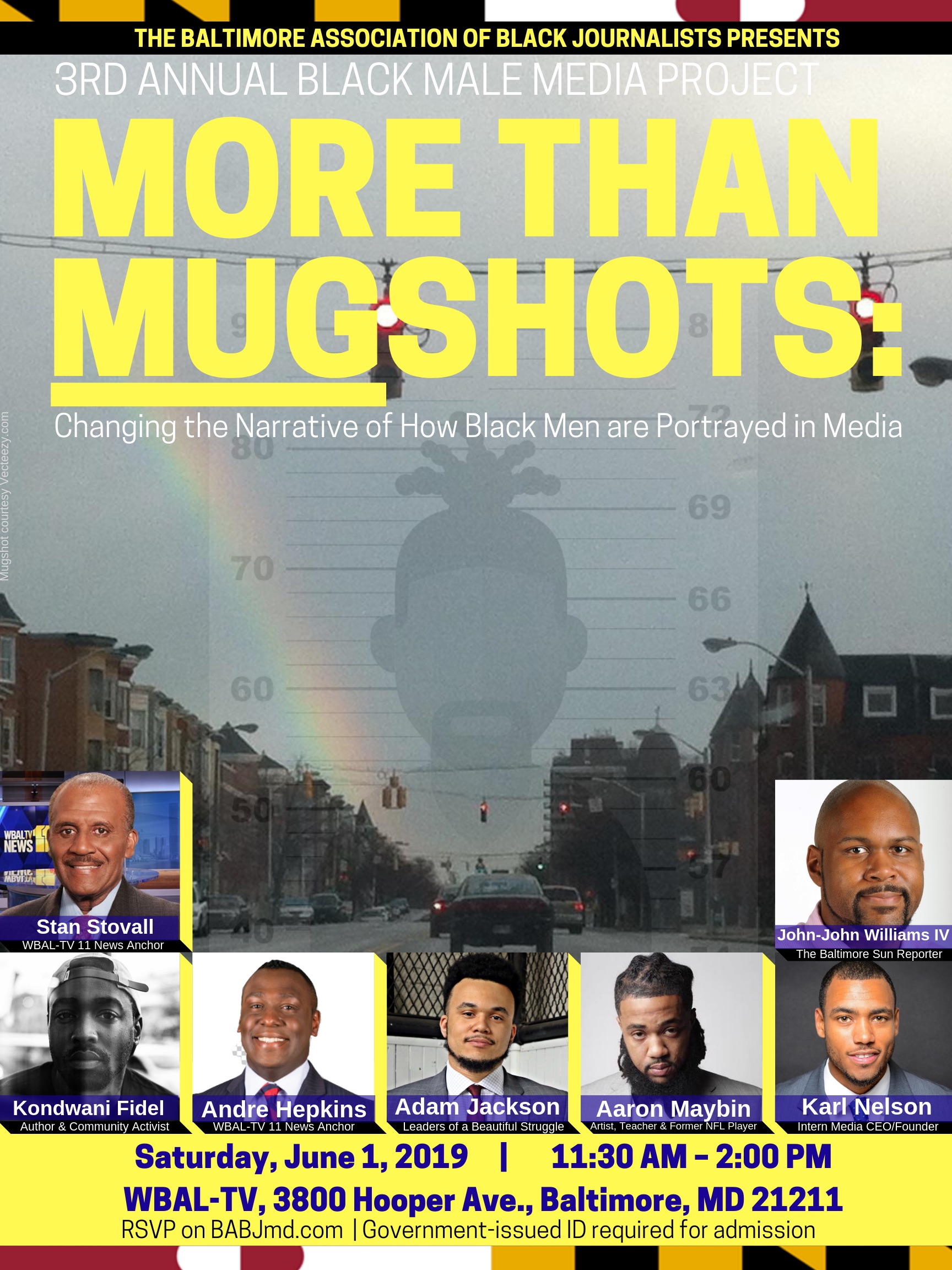
The Baltimore Association of Black Journalists hosted its 3rd annual Black Male Media Project June 1, 2019 at WBAL-TV 11. The National Association of Black Journalists #InspireBlackMen initiative aims to inspire, support and develop training and mentorship opportunities for Black men working in journalism and media and those that aspire to.
More than 60 guests attended the free lunch and panel discussion featuring:

- Kondwani Fidel, Author & Community Activist
- Andre Hepkins, WBAL-TV 11 News Anchor
- Adam Jackson, Leaders of a Beautiful Struggle
- Aaron Maybin, Artist, Teacher & Former NFL Player
- Karl Nelson, Intern Media CEO/Founder
- John-John Williams IV, The Baltimore Sun Reporter
MODERATOR: Stan Stovall, WBAL-TV 11 News Anchor
THE ISSUE:
WBAL-TV veteran anchor Stan Stovall narrated an educational video detailing the impact of negative images of African-American men and boys on journalism. The story written, produced and edited by BABJ Immediate President Nicki Mayo served as a springboard for the two hour forum on ways to improve the community trust between journalists serving the Baltimore media market and Black men and boys.
PHOTO GALLERY

View 2019 #InspireBlackMen images by Vance Brinkley and Randolph Smith.
THE DISCUSSION: VIEW THE FACEBOOK LIVE STREAM
The Facebook Live stream was facilitated by Malik Edwards, Digital Media Center Producer at Morgan State University’s School of Global Journalism and Communication.
The esteemed panel lead the conversation as the group tackled the following issues:
- Why are mugshots used in the media?
- Who makes the call?
- How is the community impacted by the images?
- What’s the solution?
WMAR-TV’s Skyler Henry assisted with facilitating the audience Q&A.
Community leaders and stakeholders from across the region actively voiced their observations of Baltimore news organizations and how these companies approach coverage.
Baltimore City Council President Brandon Scott was among those in attendance adding to the discussion. He applauded efforts by several news orgs to offer balanced coverage, while also addressed the missing positive stories and a need for media accountability with communities that express feelings of being misrepresented in stories.
Baltimore County Executive Johnny Olszewski, Jr.’s Press Secretary T.J. Smith also addressed the room about access to mugshots and department of motor vehicles photos. As the former chief spokesperson and communications advisor for the Baltimore Police Department (during the 2015 unrest following the death of Freddie Gray), Smith suggested news organizations connect with multiple sources to get images of crime victims instead of using previous mugshots that are not applicable to the story.
The collective group worked together to hash out many of the underlying causes of misrepresentations of Black men and boys in news. They also addressed the impact of rhetoric and dog whistles on the communities being covered.
WBAL-TV’s Director of Programming and Public Affairs Jerome Chester said his station runs a Sunday morning program called “11 TV Hill” that features a segment called “Positively Baltimore.” But he voiced concern about the lack of people reaching out the the station to share their stories.
The Baltimore Sun Diversity Committee member John-John Williams IV said the newspaper is actively working to improve and mend rifts with Baltimore’s Black community. This includes beefing up newsroom diversity with the introduction of several new staff reporters including three Black men. Two Black women were also recently hired to Baltimore Sun Media Group newsrooms statewide. The Sun is also planning trainings to encourage and teach the public how to effectively write Op-Ed pieces and submit obituaries. These are two sections of the newspaper and online product that are lacking representation from people of color.
WMAR-TV Executive Producer Calvin Johnson chimed in on the Facebook Live feed to mention his company has a segment called “Everyday Heroes” featuring positive members of the Baltimore community. Many of these stories center on African-Americans.
Moving forward, BABJ is looking for ways to help news organizations improve their connection with the Baltimore Black community. The organization plans to devise an action plan to help guide news organizations struggling with fair accurate coverage of Black men and boys. BABJ will also work with fellow community stakeholders to develop a Google drive style communications list to help them reach news organization with their positive stories. Leaders are also debating a media training day to help Black community leaders understand how news organizations operate and how to effectively manage the messaging of their respective organizations.
BABJ’s 2019 Black Male Media Project was organized, produced and promoted by:
- Jerome Chester, Director of Programming and Public Affairs
- Tramon Lucas, BABJ Student Liaison
- David C. Steele, BABJ Membership Chair
- Benét J. Wilson, BABJ President
- Nicki Mayo, BABJ Immediate Past President
###
PART 1: 2019 BABJ Black Male Media Project
PART 2: 2019 BABJ Black Male Media Project
PART 3: 2019 BABJ Black Male Media Project
PART 4: 2019 BABJ Black Male Media Project
PART 5: 2019 BABJ Black Male Media Project
PART 6: 2019 BABJ Black Male Media Project
PART 7: 2019 BABJ Black Male Media Project
PART 8: 2019 BABJ Black Male Media Project
PART 9: 2019 BABJ Black Male Media Project
===


